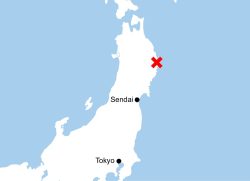16:05 JST, August 19, 2024
Unless the risk of a crash is eliminated following an investigation into the causes, residents living near bases will not feel safe. The government should continue to demand that the U.S. government implement thorough safety measures.
The U.S. military has released an investigation report on the accident in which a U.S. military Osprey aircraft crashed off the coast of Yakushima Island in Kagoshima Prefecture in November last year, killing all eight crew members on board. The report concluded that a combination of equipment failure and human error caused the incident.
According to the report, the aircraft lost stability mid-flight when the gearbox that transfers engine power to the rotor on the left wing failed.
The gears inside the gearbox rotate at high speeds, and parts can wear out and cause problems. For this reason, a system that detects and warns of gearbox abnormalities had been installed in Osprey aircraft.
An alert indicating a gearbox failure was displayed five times in the aircraft. The pilot’s manual stipulates that the aircraft should land in the vicinity when an alert is displayed three times. The report said that inadequate risk management by the pilot also contributed to the accident.
The lack of safety awareness by the pilot is surprising. However, it should be important first to prevent a situation in which a gearbox malfunction occurs.
The U.S. military currently operates a total of about 30 Osprey aircraft out of Yokota Air Base and Futenma Air Station. Japan has also imported 17 Ospreys from the United States and has stationed them at Camp Kisarazu. In the future, they will be operated out of a camp to be established near Saga Airport for use in the defense of remote islands.
The U.S. military and the Self-Defense Forces had temporarily suspended Osprey operations after last year’s accident but resumed them in March this year. As a new safety measure, they said they have increased the frequency of gearbox inspections and maintenance, but is that enough?
At a press conference, Defense Minister Minoru Kihara said, “Things that have form will always break. This is not limited to Ospreys.”
Osprey aircraft have also been involved in crashes in the United States and Australia, and there are many who doubt its safety. The defense minister is being too irresponsible by stating in general terms that there is no such thing as 100% safety, as if the accident were beyond human control.
Combining the functions of both a helicopter and a fixed-wing aircraft, the Osprey is characterized by its capability to fly long distances at high speed. Since it can take off and land vertically, it can operate without a runway.
The U.S. military used Ospreys to deliver supplies to disaster-affected areas after the 2016 Kumamoto Earthquake. Although the SDF have not used Ospreys in a disaster relief mission, such a situation can be expected in the future.
Reducing the likelihood of accidents will be a prerequisite for expanding the scope of their utilization.
(From The Yomiuri Shimbun, Aug. 18, 2024)
"Editorial & Columns" POPULAR ARTICLE
-

Artificial Intelligence Expands Possibilities for Foreign Language Learners
-

Build Intellectual, Physical Strength, As Well As Communicative Power / Japan Should Move from Beneficiary to Shaper of World Order
-

Global Economy in Turmoil: Prevent Free Trade System from Going Adrift / Risks to Financial Markets Must Be Heeded
-

Japan-China Strain Set to Persist as Beijing Officials Self-Interestedly Bash Tokyo; Takaichi Unlikely to Back Down
-

French and German Ambassadors to Japan Call for Democracies to Unite in Defense against Russian Disinformation
JN ACCESS RANKING
-

As Chinese Tourists Shun Japan, Hotels and Stores Suffer
-

Osaka-Kansai Expo’s Economic Impact Estimated at ¥3.6 Trillion, Takes Actual Visitor Numbers into Account
-

Japan Govt Adopts Measures to Curb Mega Solar Power Plant Projects Amid Environmental Concerns
-

BOJ Gov. Ueda: Highly Likely Mechanism for Rising Wages, Prices Will Be Maintained
-

Economic Security Panels Debate Supply Chains, Rare Earths; Participants Emphasize Importance of Cooperation Among Allies




















